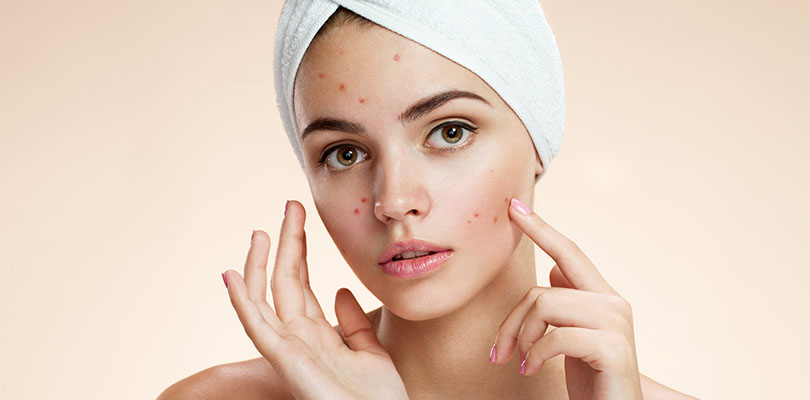What Can Tea Tree Oil Do for Acne?
Skincare can be complicated. Remember thinking in high school that acne would be short-lived? Unfortunately for some of us, that dream went out the window.
After the teenage awkwardness phase, we were supposed to be blessed with a flawless complexion, weren’t we? Perhaps acne doesn’t understand how the system is supposed to work.
Anybody at any age can get acne. However, typical products to treat acne are chemical-based. If you’re looking for a natural solution to your acne issues, you may want to consider tea tree oil.
What Is Tea Tree Oil?
Tea tree oil is natural with a pleasant smell and has antimicrobial, antiseptic, cosmetic, and anti-inflammatory properties. With these attributes, it’s no wonder that this oil is found in soaps, astringents, and shampoos. However, it is difficult to identify the concentration and purity of the tea tree oil in these products.
Tea tree oil is an essential oil from the leaves of an evergreen shrub with needle-like leaves called the Melaleuca alternifolia – or paperbark (aka tea tree) if you prefer.
The tea tree essential oil is obtained from steam distillation of the leaves. Tea tree oil is used in several medical applications including, but not limited to, coughs, earaches, colds, psoriasis, cold sores, and skin infections.
Before you start using this oil, consult with your dermatologist so they can help advise you on whether this acne remedy is an appropriate choice for you. You can purchase the oil at a health food or organic beauty supply store.
Be sure to purchase 100% tea tree oil and not an essential oil where tea tree oil is one of several ingredients. Do yourself a favor and read the label to avoid this mistake.
What Are the Benefits of Tea Tree Oil on Skin?
As a facial cleanser, tea tree oil destroys bacteria on the surface of the skin – thereby treating the existing acne. It also has exfoliating properties, and the oil goes into the pores to exfoliate the inside.
The oil helps kill the bacteria living in your skin, heal your pimples, and prevent future outbreaks. Since it is an oil, it can leave a greasy film on your face, so you may choose to dilute the oil with some distilled water before application.
How to Use Tea Tree Oil for Acne
- You may choose to steam your pores open beforehand; this option makes the oil more effective, but this step is not required.
- After using your regular face wash, spot treat acne by soaking a cotton ball or swab with the oil and apply directly to the blemishes on clean, dry skin.
HIV infection takes its toll in three stages: acute, chronic, and AIDS. Learn more about the stages of HIV in detail here.
It's important to use only a small amount of oil and test one of your trouble areas first so you can see how your skin will react. If the oil causes redness to your skin, you can dilute the tea tree oil with aloe vera gel or honey.
- To treat larger areas of the skin, mix five drops of tea tree oil with two teaspoons of raw honey.
- Rub the mixture on your face and rinse off after a minute.
- Alternatively, create a mask by mixing the oil with organic clay from a beauty supply store (again, you can dilute the tea tree oil with honey or aloe vera). After fifteen minutes, wash the mask away with warm water.
Using Tea Tree Oil for Acne Scars
By popping pimples, scratching, and trying to deal with acne, tiny scars can form on the skin from your interference. The use of tea tree oil may gradually diminish the scars. Use two to four drops of tea tree oil mixed with coconut oil and rub onto the affected area twice a day.
How Long Does Tea Tree Oil Take to Work on Acne?
The effects of tea tree oil take place over a long period of time. Tea tree oil takes longer to heal acne than medicated skin care products, but this home remedy is a gentler treatment option than many drug-store products.
There have been studies that show tea tree oil works more slowly than benzoyl peroxide (an ingredient in many over-the-counter products for fighting acne).
The essential oil, like other cleansers, helps slough off dead skin cells, and reduce the appearance of inflammation, but produces fewer side effects.
What Are the Side Effects of Tea Tree Oil?
Always test out the tea tree oil on a small patch of skin before washing your entire face. This oil is highly concentrated and can cause skin irritation if it isn’t diluted.
Only apply to the skin in moderate amounts as some people may develop an allergic rash, blistering, or itching. In some cases, tea tree oil may be a source of allergic contact dermatitis.
Only use tea tree oil topically, this oil should not be ingested as oral poisoning could be a result. Also avoid using the oil around the eyes, ears, and nostrils. This should be used with caution for those with eczema or sensitive skin conditions, children, and pregnant/breastfeeding women.
Confirm with your physician or dermatologist to determine if tea tree oil is advisable for you.
Your face is your calling card. You don’t want to try a new product where the “solution” to your acne leads to other disasters. Tea tree oil isn’t a solution for everyone, but it is a natural option that could be a welcome addition to your skin care regimen.







